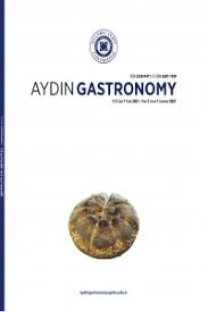Gıda ve Tarım Ürünlerinde AB Tescilli Coğrafi İşaretlerin Ayırt Edici Özellikleri ve Coğrafi Alan ile olan Bağının İncelenmesi
Coğrafi işaret; kalitesi, tarihsel, coğrafi ve sosyal geçmişiyle ilişkilendirilen ünü ve diğer ayırt edici özellikleri bakımından menşeine bağlı olan ürünlerin, benzerlerinden farklılığını tanımlamak için kullanılan bir uygulama olarak değerlendirilebilir. Bu bağlamda, ürünlerin özelliklerinin iyi tanımlanmış olması ve coğrafi alan ile olan kurulan güçlü bağ, o ürünün katma değer yaratmasını ve farklılaşma yoluyla niş pazarlara erişimi teşvik eder. Avrupa Birliği, tarım ve gıda ürünlerinin kökenlerinin korunması konusunda uzun bir geçmişe, kapsamlı bir hukuki çerçeveye ve öncü role sahiptir. Bu çalışmada, AB’de tescilli coğrafi işaretlerin ayırt edici özellikleri ve coğrafi alan ile olan bağları incelenerek analiz edilmiştir. Ayrıca, farklı coğrafi işarete sahip ürün grupları için önemli ayırt edicilik kriterleri ve bunların coğrafi alan ile olan bağ ilişkileri birbirleriyle karşılaştırılmıştır.
Characteristics of EU Registered Geographical Indications of Food and Agricultural Products and Investigation of Their Relationship with the Geographical Area
Geographical indications can be defined as an application to identify products whose quality, reputation, or other characteristics are connected to its place of origin. A strong link to a geographical area and well-defined characteristics promote the creation of value-added and access to niche markets through differentiation. The European Union has a long history, a comprehensive legal framework and a pioneering role in preserving the origins of agriculture and food products. In this study, characteristics of geographical indications registered in the EU and their relations with the geographical area were analyzed. Distinctive features and links with the geographical area were determined and compared for different product groups.
___
- Barham, E. (2003). Translating terroir: The global challenge of French AOC labelling. Journal of Rural Studies, 19(1), 127–138.
- Barham, E., Sylvander, B. (2011). Labels of origin for food: Local development, global recognition. Wallingford: CABI Publishing.
- Barjolle, D., Sylvander, B. (2002). Some factors of success for origin labelled products in agri-food supply chains in Europe: market, internal resources and institutions. Economies et Sociétés, 25(9–10), 1441-1461.
- Belletti, G., Marescotti, A., Sanz-Cañada, J., Vakoufaris, H. (2015). Linking protection of geographical indications to the environment: Evidence from the European Union olive-oil sector. Land Use Policy, 48, 94–106.
- Bérard, L., Marchenay, P. (2006). Local products and geographical indications: Taking account of local knowledge and biodiversity. International Social Science Journal, 58(187), 109–116.
- European Commission (2012). Regulation (EU) No 1151/2012 of the European Parliament and of the Council of 21 November 2012. http://eurlex.europa.eu/LexUriServ/LexUriServ.do?ur i=OJ:L:2012:343:0001:0029:en:PDF
- European Commission (2020). eAmbrosia – the EU geographical indications register. https://ec.europa.eu/info/food-farmingfisheries/food-safety-andquality/certification/qualitylabels/geographical-indications-register/
- Fernández-Ferrín, P., Bande, B., GalánLadero, M. M., Martín-Consuegra, D., Díaz, E., Castro-González, S. (2019). Geographical indication food products and ethnocentric tendencies: The importance of proximity, tradition, and ethnicity. Journal of Cleaner Production, 241, 118210.
- Giovannucci, D., Josling, T. E., Kerr, W., O’Connor, B., Yeung, M. T. (2009). Guide to Geographical Indications: Linking products and their origins. Geneva: International Trade Centre.
- Gugerell, K., Uchiyama, Y., Kieninger, P. R., Penker, M., Kajima, S., Kohsaka, R. (2017). Do historical production practices and culinary heritages really matter? Food with protected geographical indications in Japan and Austria. Journal of Ethnic Foods, 4(2), 118–125.
- Hegnes, A. W. W. (2019). The map and the terroir: Adapting geographical boundaries for PDO and PGI in Norway. British Food Journal, 121(12), 3024–3042.
- Josling, T. (2006). The War on Terroir: Geographical indications as a transatlantic trade conflict. Journal of Agricultural Economics, 57(3), 337–363.
- Quiñones Ruiz, X. F., Forster, H., Penker, M., Belletti, G., Marescotti, A., Scaramuzzi, S., Altenbuchner, C. (2018). How are food geographical Indications evolving? – An analysis of EU GI amendments. British Food Journal, 120(8), 1876–1887.
- WIPO (2017). Geographical Indications: An Introduction. Geneva: World Intellectual Property Organization
- Zappalaglio, A. (2019). The Debate Between the European Parliament and the Commission on the Definition of Protected Designation of Origin: Why the Parliament Is Right. IIC International Review of Intellectual Property and Competition Law, 50(5), 595–610.
- ISSN: 2528-9411
- Yayın Aralığı: Yılda 2 Sayı
- Başlangıç: 2017
- Yayıncı: İSTANBUL AYDIN ÜNİVERSİTESİ
Sayıdaki Diğer Makaleler
İlkay YILMAZ, Ecem AKAY, Arda ER
Yeni Tip Koronavirüs (Covid-19) Salgınının Dünya Gıda Sistemi Üzerindeki Etkileri
Gıda Endüstrisinde Ultrason Uygulamaları
Abdullah DİLER, Çiğdem TÜRKSÖNMEZ
Üniversite Öğrencilerinin Fermente Süt Ürünleri Tüketim Alışkanlıklarının İstatistiksel Analizi
Moleküler Gastronomi Uygulamaları: Sous Vide Yöntemi
Ebru KEMER, 0000-0001-9686-4118
